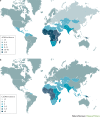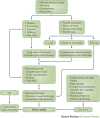Otitis media
- PMID: 27604644
- PMCID: PMC7097351
- DOI: 10.1038/nrdp.2016.63
Otitis media
Abstract
Otitis media (OM) or middle ear inflammation is a spectrum of diseases, including acute otitis media (AOM), otitis media with effusion (OME; 'glue ear') and chronic suppurative otitis media (CSOM). OM is among the most common diseases in young children worldwide. Although OM may resolve spontaneously without complications, it can be associated with hearing loss and life-long sequelae. In developing countries, CSOM is a leading cause of hearing loss. OM can be of bacterial or viral origin; during 'colds', viruses can ascend through the Eustachian tube to the middle ear and pave the way for bacterial otopathogens that reside in the nasopharynx. Diagnosis depends on typical signs and symptoms, such as acute ear pain and bulging of the tympanic membrane (eardrum) for AOM and hearing loss for OME; diagnostic modalities include (pneumatic) otoscopy, tympanometry and audiometry. Symptomatic management of ear pain and fever is the mainstay of AOM treatment, reserving antibiotics for children with severe, persistent or recurrent infections. Management of OME largely consists of watchful waiting, with ventilation (tympanostomy) tubes primarily for children with chronic effusions and hearing loss, developmental delays or learning difficulties. The role of hearing aids to alleviate symptoms of hearing loss in the management of OME needs further study. Insertion of ventilation tubes and adenoidectomy are common operations for recurrent AOM to prevent recurrences, but their effectiveness is still debated. Despite reports of a decline in the incidence of OM over the past decade, attributed to the implementation of clinical guidelines that promote accurate diagnosis and judicious use of antibiotics and to pneumococcal conjugate vaccination, OM continues to be a leading cause for medical consultation, antibiotic prescription and surgery in high-income countries.
Conflict of interest statement
The authors declare no competing interests.
Figures







References
-
- Bluestone CD, Rosenfeld RM, Bluestone CD. Evidence-Based Otitis Media. BC Decker Inc; 2003. p. 121.
-
- Cullen, K., Hall, M. & Golosinskiy, A. Ambulatory surgery in the United States, 2006. National health statistics reports, no. 11, revised. CDChttps://www.cdc.gov/nchs/data/nhsr/nhsr011.pdf (2009). - PubMed
Publication types
MeSH terms
Substances
Grants and funding
LinkOut - more resources
Full Text Sources
Other Literature Sources
Medical
Miscellaneous

